'
Saturn is the sixth planet from the Sun and is the second largest in the solar system with an equatorial diameter of 119,300
kilometers (74,130 miles). Much of what is known about the planet is due to the Voyager explorations in 1980-81. Saturn is visibly flattened at the poles, a result of the very fast rotation of the planet on its
axis. Its day is 10 hours, 39 minutes long, and it takes 29.5 Earth years to revolve about the Sun. The atmosphere is primarily
composed of hydrogen with small amounts of helium and methane. Saturn is the only planet less dense than water (about 30 percent
less). In the unlikely event that a large enough ocean could be found, Saturn would float in it. Saturn's hazy yellow hue
is marked by broad atmospheric banding similar to, but fainter than, that found on Jupiter.
The wind blows at high speeds on Saturn. Near the equator, it reaches velocities of 500 meters a second (1,100 miles an
hour). The wind blows mostly in an easterly direction. The strongest winds are found near the equator and velocity falls off
uniformly at higher latitudes. At latitudes greater than 35 degrees, winds alternate east and west as latitude increases.
Saturn's ring system makes the planet one of the most beautiful objects in the solar system. The rings are split into a number of different parts,
which include the bright A and B rings and a fainter C ring. The ring system has various gaps. The most notable gap is the
Cassini [kah-SEE-nee] Division, which separates the A and B rings. Giovanni Cassini discovered this division in 1675. The Encke [EN-kee] Division, which splits the A Ring, is named after Johann Encke, who
discovered it in 1837. Space probes have shown that the main rings are really made up of a large number of narrow ringlets.
The origin of the rings is obscure. It is thought that the rings may have been formed from larger moons that were shattered
by impacts of comets and meteoroids. The ring composition is not known for certain, but the rings do show a significant amount
of water. They may be composed of icebergs and/or snowballs from a few centimeters to a few meters in size. Much of the elaborate
structure of some of the rings is due to the gravitational effects of nearby satellites. This phenomenon is demonstrated by
the relationship between the F-ring and two small moons that shepherd the ring material.
Radial, spoke-like features in the broad B-ring were also found by the Voyagers. The features are believed to be composed
of fine, dust-size particles. The spokes were observed to form and dissipate in the time-lapse images taken by the Voyagers.
While electrostatic charging may create spokes by levitating dust particles above the ring, the exact cause of the formation
of the spokes is not well understood.
Saturn has 30 named satellites and more continue to be discovered.
| Saturn Statistics |
| Mass (kg) |
5.688e+26 |
| Mass (Earth = 1) |
9.5181e+01 |
| Equatorial radius (km) |
60,268 |
| Equatorial radius (Earth = 1) |
9.4494e+00 |
| Mean density (gm/cm^3) |
0.69 |
| Mean distance from the Sun (km) |
1,429,400,000 |
| Mean distance from the Sun (Earth = 1) |
9.5388 |
| Rotational period (hours) |
10.233 |
| Orbital period (years) |
29.458 |
| Mean orbital velocity (km/sec) |
9.67 |
| Orbital eccentricity |
0.0560 |
| Tilt of axis (degrees) |
25.33 |
| Orbital inclination (degrees) |
2.488 |
| Equatorial surface gravity (m/sec^2) |
9.05 |
| Equatorial escape velocity (km/sec) |
35.49 |
| Visual geometric albedo |
0.47 |
| Magnitude (Vo) |
0.67 |
| Mean cloud temperature |
-125°C |
| Atmospheric pressure (bars) |
1.4 |
| Atmospheric composition
Hydrogen
Helium |
97%
3% |
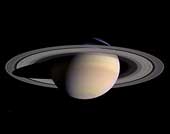 Color Image of Saturn
Color Image of Saturn
Saturn and its rings completely fill the field of view of Cassini's narrow angle camera in this natural color image. This is the last single 'eyeful'
of Saturn and its rings achievable with the narrow angle camera on approach to the planet. From now until orbit insertion,
Saturn and its rings will be larger than the field of view of the narrow angle camera.
Color variations between atmospheric bands and features in the southern hemisphere of Saturn, as well as subtle color differences
across the planet's middle B ring, are now more distinct than ever. Color variations generally imply different compositions.
The nature and causes of any compositional differences in both the atmosphere and the rings are major questions to be investigated
by Cassini scientists as the mission progresses.
The bright blue sliver of light in the northern hemisphere is sunlight passing through the Cassini Division in Saturn's
rings and being scattered by the cloud-free upper atmosphere.
Two faint dark spots are visible in the southern hemisphere. These spots are close to the latitude where Cassini saw two
storms merging in mid-March. The fate of the storms visible here is unclear. They are getting close and will eventually merge
or squeeze past each other. Further analysis of such dynamic systems in Saturn's atmosphere will help scientists understand
their origins and complex interactions. (Courtesy NASA/JPL/STSCI)
 Saturn With Rhea and Dione
Saturn With Rhea and Dione
NASA's Voyager 2 took this photograph of Saturn on July 21, 1981, when the spacecraft was 33.9 million kilometers (21 million miles) from
the planet. Two bright, presumably convective cloud patterns are visible in the mid-northern hemisphere and several dark spoke-like features can be seen in the broad B-ring
(left of planet). The moons, Rhea and Dione, appear as blue dots to the south and southeast of Saturn, respectively. Voyager 2 made its closest approach to Saturn on
August 25, 1981. (Courtesy NASA/JPL)
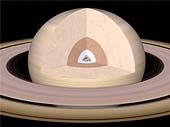 The Interior of Saturn
The Interior of Saturn
This picture illustrates the internal structure of Saturn. The outer layer is primarily composed of molecular hydrogen.
As we go deeper where the presure reaches 100,000 bars, the gas starts to resemble a hot liquid. When the hydrogen reaches
a pressure of 1,000,000 bar, hydrogen changes into a new state of metallic hydrogen. In this state it resembles a molten metal.
This metalic hydrogen state occurs at about half of Saturn's radius. Below this is a layer dominated by ice where "ice" denotes
a soupy liquid mixture of water, methane, and ammonia under high temperatures and pressures. Finally at the center is a rocky
or rocky-ice core. (Copyright 2002 Calvin J. Hamilton)
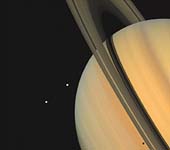 Saturn With Tethys and Dione
Saturn With Tethys and Dione
Saturn and two of its moons, Tethys (above) and Dione, were photographed by Voyager 1 on November 3, 1980, from a distance of 13 million kilometers (8 million miles). The shadows
of Saturn's three bright rings and Tethys are cast onto the cloud tops. The limb of the planet can be seen easily through
the 3,500-kilometer-wide (2,170 mile) Cassini Division, which separates ring A from ring B. The view through the much narrower
Encke Division, near the outer edge of ring A is less clear. Beyond the Encke Division (at left) is the faintest of Saturn's
three bright rings, the C-ring or crepe ring, barely visible against the planet. (Courtesy NASA/JPL)
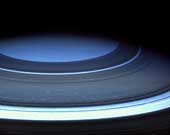 Saturn's Blue Cranium
Saturn's Blue Cranium
Saturn's northern hemisphere is presently a serene blue, more befitting of Uranus or Neptune, as seen in this natural color image from Cassini.
Light rays here travel a much longer path through the relatively cloud-free upper atmosphere. Along this path, shorter
wavelength blue light rays are scattered effectively by gases in the atmosphere, and it is this scattered light that gives
the region its blue appearance. Why the upper atmosphere in the northern hemisphere is so cloud-free is not known, but may
be related to colder temperatures brought on by the ring shadows cast there.
Shadows cast by the rings surround the pole, looking almost like dark atmospheric bands. The ring shadows at higher latitudes
correspond to locations on the ringplane that are farther from the planet--in other words, the northernmost ring shadow in
this view is made by the outer edge of the A ring. (Courtesy NASA/JPL/Space Science Institute)
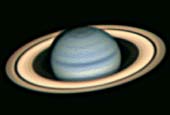 Nordic Optical Telescope
Nordic Optical Telescope
This image of Saturn was taken with the 2.6 meter Nordic Optical Telescope, located at La Palma, Canary Islands. (© Copyright Nordic Optical Telescope Scientific Association -- NOTSA)
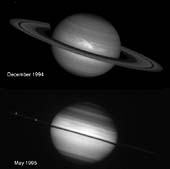 Saturn's Rings Edge-On
Saturn's Rings Edge-On
In one of nature's most dramatic examples of "now-you see-them, now-you-don't," NASA's Hubble Space Telescope captured
Saturn on May 22, 1995, as the planet's magnificent ring system turned edge-on. This ring-plane crossing occurs approximately
every 15 years when the Earth passes through Saturn's ring plane.
The rings do not disappear completely because the edge of the rings reflects sunlight. The dark band across the middle
of Saturn is the shadow of the rings cast on the planet (the Sun is almost 3 degrees above the ring plane.) The bright stripe
directly above the ring shadow is caused by sunlight reflected off the rings onto Saturn's atmosphere. Two of Saturn's icy
moons are visible as tiny starlike objects in or near the ring plane.
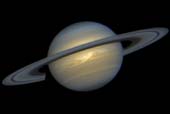 Storm on Saturn
Storm on Saturn
This image, taken by the Hubble Space Telescope, shows a rare storm that appears as a white arrowhead-shaped feature
near the planet's equator. The storm is generated by an upwelling of warmer air, similar to a terrestrial thunderhead. The
east-west extent of this storm is equal to the diameter of the Earth (about 12,700 kilometers or 7,900 miles). The Hubble
images are sharp enough to reveal that Saturn's prevailing winds shape a dark "wedge" that eats into the western (left) side
of the bright central cloud. The planet's strongest eastward winds, clocked at 1,600 kilometers (1,000 miles) per hour based
on Voyager spacecraft images taken in 1980-81, are at the latitude of the wedge.
To the north of this arrowhead-shaped feature, the winds decrease so that the storm center is moving eastward relative
to the local flow. The clouds expanding north of the storm are swept westward by the winds at higher latitudes. The strong
winds near the latitude of the dark wedge blow over the northern part of the storm, creating a secondary disturbance that
generates the faint white clouds to the east (right) of the storm center. The storm's white clouds are ammonia ice crystals
that form when an upward flow of warmer gases shoves its way through Saturn's frigid cloud tops.
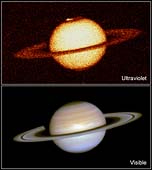 HST Views Aurora on Saturn
HST Views Aurora on Saturn
The top image shows the first image ever taken of bright aurorae at Saturn's northern and southern poles, as seen in
far ultraviolet light by the Hubble Space Telescope. Hubble resolves a luminous, circular band centered on the north pole,
where an enormous auroral curtain rises as far as 2,000 kilometers (1,200 miles) above the cloudtops. This curtain changed
rapidly in brightness and extent over the two hour period of HST observations.
The aurora is produced as trapped charged particles precipitating from the magnetosphere collide with atmospheric gases.
As a result of the bombardment, Saturn's gases glow at far-ultraviolet wavelengths (110-160 nanometers). These wavelengths
are absorbed by the Earth's atmosphere, and can only be observed from space-based telescopes.
For comparison, the bottom image is a visible-light color composite of Saturn as seen by Hubble on December 1, 1994. Unlike
the ultraviolet image, Saturn's familiar atmospheric belts and zones are clearly seen. The lower cloud deck is not visible
at UV wavelengths because sunlight is reflected from higher in the atmosphere.
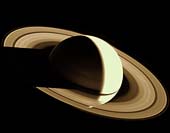 Last View of Saturn
Last View of Saturn
Two days after its encounter with Saturn, Voyager 1 looked back on the planet from a distance of more than 5.0 million kilometers (3.0 million miles). This view of Saturn has
never been seen by an earth based telescope, since the earth is so close to the Sun only the sunlit face of Saturn can be
seen. (Copyright © 2002 Calvin J. Hamilton)
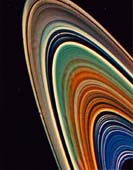 False Color Image of Saturn's Rings
False Color Image of Saturn's Rings
Possible variations in chemical composition from one part of Saturn's ring system to another are visible in this Voyager
2 picture as subtle color variations that can be recorded with special computer-processing techniques. This highly enhanced
color view was assembled from clear, orange and ultraviolet frames obtained August 17, 1981 from a distance of 8.9 million
kilometers (5.5 million miles). In addition to the previously known blue color of the C-ring and the Cassini Division, the
picture shows additional color differences between the inner B-ring and and outer region (where the spokes form) and between
these and the A-ring. (Courtesy NASA/JPL)
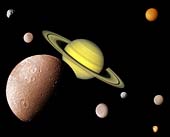 The Saturn System
The Saturn System
This picture of the Saturnian system was prepared from an assemblage of images taken by the Voyager 1 spacecraft during
its Saturn encounter in November 1980. This view shows Dione in the forefront, Saturn rising behind, Epimetheus (top-left) and Rhea just to the left of Saturn's rings. To the right and below Saturn's rings are Enceladus, Mimas, Tethys, and Iapetus (bottom-right). The cloud covered Titan is at the top-right. (Copyright Calvin J. Hamilton)
Saturn has 31 officially recognized and named satellites. In addition, there are other unconfirmed satellites. One circles in the orbit of Dione, a second is located between the orbits of Tethys and Dione, and a third is located between
Dione and Rhea. The unconfirmed satellites were found in Voyager photographs, but were not confirmed by more than one sighting.
Recently, the Hubble Space Telescope imaged four objects that might be new moons.
Several generalizations can be made about the satellites of Saturn. Only Titan has an appreciable atmosphere. Most of the satellites have a synchronous rotation. The exceptions are Hyperion, which has a chaotic orbit, and Phoebe. Saturn has a regular system of satellites. That is, the satellites have nearly circular orbits and lie in the equatorial
plane. The two exceptions are Iapetus and Phoebe. All of the satellites have a density of < 2 gm/cm3. This indicates they are composed of 30 to 40% rock and
60 to 70% water ice. Most of the satellites reflect 60 to 90% of the light that strikes them. The outer four satellites reflect
less than this and Phoebe reflects only 2% of the light that strikes it.

